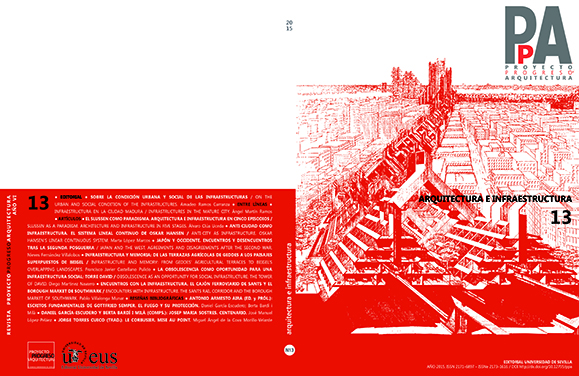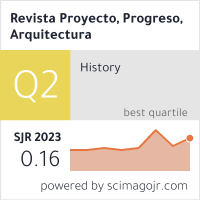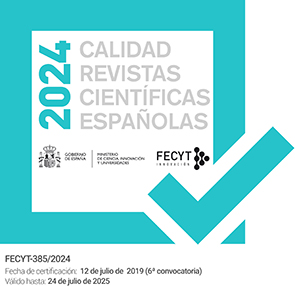ANTI-CIUDAD COMO INFRAESTRUCTURA. EL SISTEMA LINEAL CONTINUO DE OSKAR HANSEN / Anti-city as infrastructure. Oskar Hansen’s Linear Continuous System
DOI:
https://doi.org/10.12795/ppa.2015.i13.03Palabras clave:
Oskar Hansen, anti-ciudad, Polonia, infraestructura, Forma Abierta, Team X / anti-city, Poland, infrastructure, Open Form,Resumen
RESUMEN Durante las décadas de la Guerra Fría, el continente europeo se encuentra sumido en un complejo proceso de transformación, reconstrucción y planteamiento de nuevos proyectos políticos y territoriales. Esta situación es especialmente convulsa en la franja centroeuropea, donde en estados como Hungría, Polonia o la antigua Yugoslavia se daban profundos debates acerca de su identidad y su organización geopolítica. El progresivo aperturismo hacia los países occidentales, junto a la necesidad de modernizar en profundidad los sistemas e infraestructuras estatales, sirvieron como catalizadores para la proliferación de grandes proyectos territoriales y urbanos con el fin no solo de mejorar la calidad de vida de los habitantes, sino también de reforzar la posición de dichos estados en el continente y el resto del mundo. Este texto se centra en el caso de la República Popular de Polonia, donde estas cuestiones se trataron con gran profusión desde diversas ramas. Concretamente, la propuesta del arquitecto Oskar Hansen para un Sistema Lineal Continuo aúna la visión socialista del estado como agente productor del espacio con la participación individual dentro del colectivo –siguiendo su Teoría de la Forma Abierta y sus conexiones con el Team X- sobre un soporte arquitectónico : un modelo de “anti-ciudad” que abriría cuestiones que todavía hoy permanecen vigentes.
SUMMARY During the decades of the Cold War, Europe was plunged into a complex process of transformation, reconstruction and the emergence of new political and territorial projects. This situation caused particular upheaval in the central European strip, where states such as Hungary, Poland and the former Yugoslavia were struck by a profound quandary as to their identity and their geopolitical organisation. As they gradually opened up towards western countries and understood the need to drastically modernise the states’ systems and infrastructures, this triggered the proliferation of large-scale land planning and urban planning projects with a view to not only improving the quality of life of their inhabitants, but also strengthening their position on the continent and worldwide. This paper focusses particularly on the case of the People’s Republic of Poland, where such issues were tackled profusely from a number of angles. As a specific example, the idea by architect Oskar Hansen of a Linear Continuous System combines the socialist vision of the State as a producer of space with the concept of individual participation within a group – following his Theory on Open Form and his connections with Team X – based on an architectural substrate: the model of an “anti-city”, which gave rise to issues that remain relevant to this day.
Descargas
Citas
Allen, Stan: Points + lines: diagrams and projects for the city. New York: Princeton Architectural Press, 1999.
Allen, Stan: “From the biological to the geological”. En Allen, Stan; McQuade, Marc (Eds.): Landform Building: Architecture’s New Terrain. Baden: Lars Müller Publishers, 2011. pp. 20-37.
Boeri, Stefano: “The Anti-city”. En Abitare. Junio 2011, Nº 513. Milán: Editrice Abitare Segesta. 1962. pp. 37-42.
Hansen, Oskar: “La forme ouverte dans l’architecture - L’art du Grand Nombre”. En Le Carré Bleu. 1961, Nº 1. Helsinki: CIAM-Finland. 1961. pp. 4-5.
Hansen, Oskar: “Proposition pour un système d’urbanisme linéaire”. En Le Carré Bleu. 1969, Nº 2. Helsinki: CIAM-Finland. 1961. pp. 1-4.
Hansen, Oskar: “Die Offene Form”. En Werk. Septiembre 1971, Vol. 48, Nº 9. Zúrich: Bund Schweizer Architekten. 1914. pp. 614-624. DOI: http://dx.doi.org/10.5169/seals-45085
Kędziorek, Aleksandra; Stanek, Łukasz: “Architecture as a Pedagogical Object: What to preserve of the Przyczółek Grochowski housing estate by Oskar & Zofia Hansen in Warsaw?” En A&U Architektúra & Urbanizmus. 2012, Nº 3-4. Bratislava: Institute of Construction and Architecture. Slovak Academy of Sciences. 2006. pp. 250-269.
Kohlrausch, Martin: “The communication of architecture as transnational experience: Poland in the interwar period”. En The Canadian Centre for German and European Studies Working Paper Series. 2008, Nº 16.
Toronto-Montréal: CCGES York University- CCEAE Université de Montréal, 2001, pp. 1-19.
Lefebvre, Henri: The urban revolution. Minneapolis-Londres: University of Minnesota Press, 2003.
Lefebvre, Henri: La Producción del Espacio. Madrid: Capitán Swing, 2013.
McKim, Joel: “Radical Infrastructure? A New Realism and Materialism in Philosophy and Architecture”. En Lahiji, Nadir (Ed.): The missed Encounter of Radical Philosophy with Architecture. Londres-Nueva York: Bloomsbury Academic, 2014. pp. 132-149.
Obrist, Hans Ulrich; Parreno, Philippe: “Interview with Oskar Hansen”. En Domus. 2004, Nº 868 (separata). Rozzano, Milán: Editoriale Domus. 1928. pp. 17-31.
Stanek, Łukasz (Ed.): Team 10 East. Revisionist Architecture in Real Existing Modernism. Varsovia: Museum of Modern Art in Warsaw, 2014. pp. 210-241.
Scott, Felicity D.: “Space Educates”. En Kędziorek, Aleksandra; Ronduda, Łukasz (Ed.): Oskar Hansen: Opening Modernism. On Open Form, Architecture, Art and Didactics. Varsovia: Museum of Modern Art in Warsaw, 2014. pp. 136-160.
Szczerski, Andrzej: “LCS, or what is a City?” En Kędziorek, Aleksandra; Ronduda, Łukasz (Ed.): Oskar Hansen: Opening Modernism. On Open Form, Architecture, Art and Didactics. Varsovia: Museum of Modern Art in Warsaw, 2014. pp. 90-113.
Zalski, Tadeusz: “LSC czyli jak budować antymiasta” (Entrevista con Oskar Hansen). En Życie Gospodarcze. Marzo 1969, Nº 9. Varsovia: Spółdzielnia Wydawnicza “Życie Gospodarcze”. 1945. pp. 1–2.
Descargas
Publicado
Cómo citar
Número
Sección
Licencia
Las ediciones impresa y electrónica de esta Revista son editadas por el Secretariado de Publicaciones de la Universidad de Sevilla, siendo necesario citar la procedencia en cualquier reproducción parcial o total.
Salvo indicación contraria, todos los contenidos de la edición electrónica se distribuyen bajo una licencia de uso y distribución “Creative Commons Atribución-NoComercial-SinDerivar 4.0 Internacional” ![]() . Puede consultar desde aquí la versión informativa y el texto legal de la licencia. Esta circunstancia ha de hacerse constar expresamente de esta forma cuando sea necesario.
. Puede consultar desde aquí la versión informativa y el texto legal de la licencia. Esta circunstancia ha de hacerse constar expresamente de esta forma cuando sea necesario.
Los autores/as que publiquen en esta revista aceptan las siguientes condiciones:
- Los autores/as conservan los derechos de autor y ceden a la revista el derecho de la primera publicación, con el trabajo registrado con la licencia de atribución de Creative Commons, que permite a terceros utilizar lo publicado siempre que mencionen la autoría del trabajo y a la primera publicación en esta revista.
- Los autores/as pueden realizar otros acuerdos contractuales independientes y adicionales para la distribución no exclusiva de la versión del artículo publicado en esta revista (p. ej., incluirlo en un repositorio institucional o publicarlo en un libro) siempre que indiquen claramente que el trabajo se publicó por primera vez en esta revista.
- Se permite y recomienda a los autores/as a publicar su trabajo en Internet (por ejemplo en páginas institucionales o personales) antes y durante el proceso de revisión y publicación, ya que puede conducir a intercambios productivos y a una mayor y más rápida difusión del trabajo publicado (vea The Effect of Open Access).









